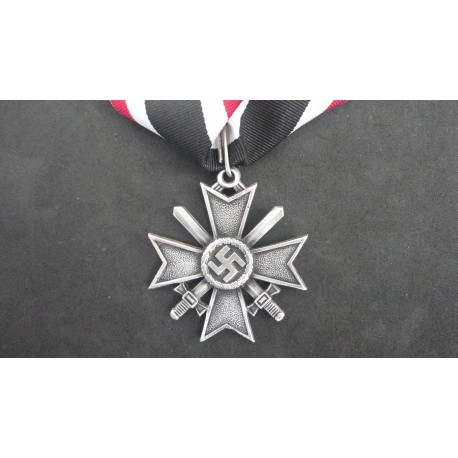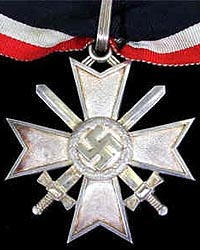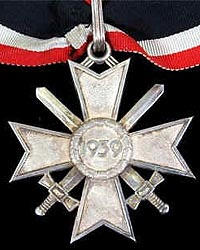No products
Best sellers
-

WW2 - SS Officer Visor Cap Skull with Eagle - Metal
Recommended by us due to the High Quality and detail of this product....
£ 19.99 -

WW2 - SS Officer Visor Cap Skull - Superior
Recommended by us due to the High Quality and detail of this product....
£ 11.99 -

WW2 Iron Cross with Oak Leaves and Swords,included Ribbon - SUPERIOR
Recommended by us due to the High Quality and detail of this product....
£ 19.99 -

WW2 The Knights Cross of the Iron Cross - in gold
Recommended by us due to the High Quality and detail of this product....
£ 21.99 -

WW2 German U-Boat War Badge - in Silver
Recommended by us due to the High Quality and detail of this product....
£ 14.99 -

WW2 - Luftwaffe Officer Visor Cap Eagle
Recommended by us due to the High Quality and detail of this product....
£ 12.99 -

WW2 - SS Officer Visor Cap Eagle - Superior
Recommended by us due to the High Quality and detail of this product....
£ 12.99 -

WW2 N.S.D.A.P - Golden Party Badge
Full size type,numbered and marked to The Golden Party Badge....
£ 17.99 -

WW2 - SS Skull Badge - ( Mine Honor is True Jewelry )
Recommended by us due to the High Quality and detail of this product....
£ 11.99 -

WW2 Clasp 1939 to the Iron Cross
Recommended by us due to the High Quality and detail of this product....
£ 13.99
ww2 German Iron Cross
No manufacturer
-

WW2 - SS Skull Badge - ( Mine Honor is True Jewelry )
Recommended by us due to the High...
£ 11.99 £ 13.99
No supplier
Viewed products
-

WW2 Knights Cross to...
Recommended by us due to the High...
WW2 Knights Cross to the War Merit Cross - in Silver
New product
Recommended by us due to the High Quality and detail of this product.
Will not be disappointed with the quality of item.
----Looks Like Orginal----
3 Items
Warning: Last items in stock!
More info
The Knights Cross to the War Merit Cross (Ritterkreuz des Kriegsverdienstkeuzes), was introduced on August 19th, 1940 at the same time as the War Merit Medal. Its ranking in the German award structure was above the German Cross in Silver and Gold, but below the Knights Cross to the Iron Cross. It was awarded sparingly over the war years, and because so few were presented the Cross was held in high regards by the Nazi hierarchy, giving it an aura of exclusivity which it may not have fully deserve since it ranked below the Knights grade of Iron Cross. Great ceremonies were normally staged around recipients, with Hitler almost always presenting the award in front of high ranking Military and party officials. In the last year of the War, the Knights Cross in Gold was introduced as the highest grade of the War Merit Cross. Partly due to its late introduction date, this award was presented only a handful of times.
|
|
|
A minority of recipients were not announced in the press in order to protect the sensitive work in which they were involved. This was the case of Dr. Ing Ernst Blaicher, who was presented with the award on November 15th, 1943 for his achievements in tank production. Another example of presentation which was not publicized was the one to Luftwaffe Oberstleutnant Othmar Wolfan, who was the on the staff of Kommandierender General der Deutschen Luftwaffe in Finland. He was recalled to Berlin in the last days of the war, presented with the award, and promoted to another position before going into Russian captivity as the Third Reich capitulated.
The Knights Cross was worn at the neck, exactly like the Knights Cross to the Iron Cross. No dress down version was provided. Below is a reproduction of the Knights Cross to the War Merit Cross with Swords, presented here only to illustrate the award. To the right is SS Brigaderfuhrer Hans Kehrl (1900-1984) during his presentation of the Knights Cross with Swords on November 27, 1944. Kehrl was Chief of Raw Materials at the time, after having served in the Armaments Office and the Industrial Section.
Award Criteria
The Knight Cross to the War Merit Cross was presented to those who already held the previous two grades. All recommendations were forward through the OKW or the Reichsminister to Hitler, who personally review and approved/denied candidates. Because the candidates were often high ranking officials those who were denied were advised, unofficially and quietly, to withdraw the application.
The non-combatant grade was used to reward the achievements of civilians, civil service agents and military merit not related to combat (such as recruiting and occupation duties). It is of interest that Hitler circulated a memorandum on August 27, 1943 specifying the criteria for the award and stating that prominent party comrades were not to be honored with this decoration. It has been put forth that the reason for this was the Hitler had the Order of the German Eagle in mind for political leadership, and wanted to reserve the War Merit Cross for achievements that were not exclusively politically related. It had also been documented, through Albert Speer, that Hitler wanted to present Himmler with a decoration but could not decide which, and Speer himself suggested that he would not mind being recognized with an award of this type.
The Knights Cross to the War Merit Cross with Swords was presented for outstanding military bravery not directly under enemy fire. This bravery was generally of a degree not deserving of the Knights Cross.
There were 211 Knights Cross to the War Merit Cross with Swords presented, and 48 were presented without Swords. Because as mentioned above not all awards were made public, and because of the hectic conditions toward the end of the war, new recipients may come to light in the future.
Recipients
Knights Cross to the War Merit Cross holder Gottlob Berger is an excellent example of an officer whose career achievements earned him decorations and through hard work and courage to be sure, but also by pleasing the right people. He was born on July 16th, 1897 in Gerstetten, Wurttemberg and served in the Imperial Army during World War I. He became a highly decorated officer, and was wounded several times earning the rare Wound Badge in Gold. After the war he spent a short period as a teacher in his hometown while joining the Freikorps, and held the post of Director of the Regional Gymnastic Institute in Stuttgart. On August 1, 1938, he joined the SS and became Director of the SS Sports Office, and on December 1 of the same year, due to his experience and high recommendations from the Army, he was officially given the rank of SS Standartenfuhrer.
The outbreak of war found him in this position, but on April 1st, 1940 Berger became Head of the Main SS Recruiting Office. This post had previously held by Heissmeyer, and Berger was involved in the administrative restructuring of the Office. It was really at this position that he excelled; On April 20th, 1940 he was promoted to SS Brigaderfuhrer. His career was aided by many pre-war connections, which allowed him to conduct many successful recruiting campaigns in the conquered Reich Territories. During the next two years he surpassed set standards and on July 1st, 1943 received the German Cross in Silver.
Knights Cross to the War Merit Cross in Gold
On July 7th, 1944 Albert Speer brought to Hitlers attention the need for a higher award, and the Knights Cross to the War Merit Cross in Gold was instituted on October 13th, 1944 (other sources state that the award was instituted on the date of Speers meeting with Hitler). This award ranked above the Knights Cross to the Iron Cross but below the Oak Leaves, and was identical in every way to the Silver grade save that it was gold plated. It was created with and without swords, but only the non-combatant grade was presented. One such presentation took place on Hitlers last birthday, April 20th, 1945 when Speer presented the Cross to Franz Hahne and Karl Otto Saur, and only 21 were awarded by wars end.
It is believed that the Gold grade was created by simply gold plating the existing silver grades. Though only a few were presented, many more were created but never awarded. Even so, this award is rare in the extreme and virtually unattainable today.
Reviews
No customer reviews for the moment.








